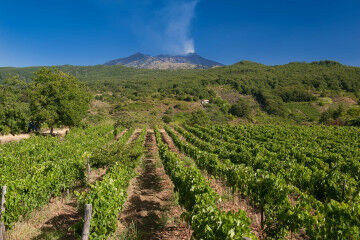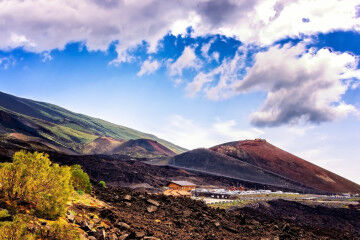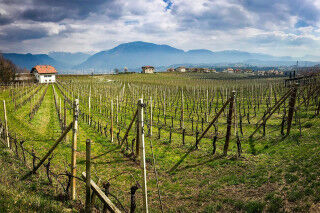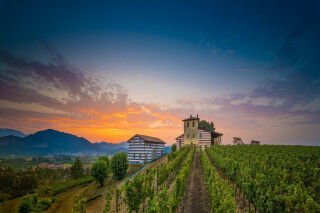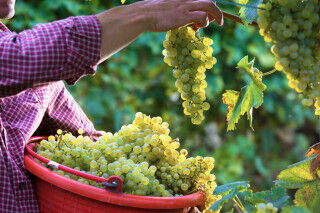WHY IS THE ETNA AREA SO PERFECT FOR WINES?
As fate would have it, just as I sit down to begin my review of the Etna DOC wine tastings I participated in, the news is flooded with reports of a new Etna eruption. Etna, Europe’s largest active volcano, is letting loose again.
It can be difficult to understand the appeal of living within the shadow of active volcanoes, with their intermittent releases of incandescent magma, and thick ashes. Yet, history proves that countless important civilizations like the Greeks and Etruscans have repeatedly opted to settle in the heart of volcanic lands.
What did they know that we don’t? In a nutshell: soil fertility. Active volcanoes in particular renew with ease the mineral profile of the soil surrounding active volcanoes.
The soil is replenished in a simple method: ashes enter the soil in a sort of aerosol action, slowing releasing their nutritional boosts even in areas where crops are already present. Some areas contain a lava flow, also called sciara. With the passage of time, the lava eventually disintegrates, leaving behind a very charged, fertile soil ideal for agricultural development. These very specific areas are locally referred to as contrade, and are home to newly-established farms.
WHAT IS THE CONSORZIO DELL’ETNA DOC’S ROLE?
Beginning from 2011, the Etna DOC Consortium has allowed the inclusion of contrade directly on their labels.
Only one other Italian area follows suit, allowing this inclusions of “additional geographical mentions” when dealing with the inclusion of Crù (single vineyards) grapes. Know which region that is? Piedmont’s own Langhe region.
When we speak of the Langhe, naturally we’re talking about Barolo and Barbaresco wines, and the Nebbiolo grape that is at the heart of these fine Northern wines. The similarities of both regions is such that people often call upon the Nebbiolo characteristics when describing the Etna red wines.
Comparisons also abound with France’s Burgundy wine region, although truth be told, the limestone matrix which rendered the Pinot Noir grape so famous is lacking in the Etna soil and region.
With these fundamental difference in mind, there are similarities between the Nebbiolo, Pinot Noir and Etna red grapes, the Nerello Mascalese. This kinship is primarily focused on the difficulties in cultivating these varietals with notable success. All three cases provide an excellent base for being "litmus vines.”
Meaning, all three varietals can reflect, with a rare aptitude, the elements of their place of original, soil composition, location, exposure and altitudes. In other words, all three varietals are vigorous examples of Crù grapes, a concept the Cistercian monks in Burgundy had already grasped as far back as the 1300s. Not to be forgotten, the farmers in Piedmont had also developed this same notion of “sorì,” in the 1800s. The Etna wine region can trace its adherence to the Crù phenomena back within the past 10 years.
TODAY’S STRUCTURE OF THE ETNA WINE REGION
Today Etna is host to 133 contrade, the same number as churches in the beautiful port city of Catania, a strange coincidence (I actually counted 134 churches in Catania!).
So many wine lovers have rightly expressed wonder at the notion of being able to recognize each contrada in a blind tasting.
Well, the quick answer is that time will need to tell, and we still need more time to explore. There are certainly contrade with more identifiable characteristics and traits, but we’re still not able to proceed with a comprehensive organoleptic mapping of the 133 districts. This is also due in part to a lack of a historical tasting record that would allow for an in-depth analysis and comparison.
Additionally, there are still at least 20% of the contrade that still need to have their areas geographically indicated. As such, for those missing contrade, we’re still lacking a reference point for altitude, soil type, and ampelographic composition.
There’s no doubt that the Consortium is making great strides and proceeding virtually unanimously towards a complete mapping structure, as Consorzio director, Maurizio Lunetta, confirms. As this process continues, we can continue our enjoyment of these extraordinary wines, focusing instead on the more macro approach of Etna slopes rather than contrade.
CHARACTERISTICS OF THE NORTHERN ETNA WINE REGION
The Etna-based vineyards surrounds the volcano in a horseshoe shape. The volcano itself is locally designated a female presence, and is often referred to as 'A Muntagna.”
Beginning on the Northern slope, in the town of Randazzo, our wine path continues through Castiglione di Sicilia, concluding in Linguaglossa and Piedimonte Etneo.
This is the most representative numerically of the contrade, with more than 60% of the DOC region’s vineyards present. Out of 133 contrade, the first two municipalities above have 71 present.
This Northern slope is a chilly area, with the DOC’s lowest maximum altitudes (it reaches 800 m.slm). The Mistral winds cool the torpid summer heat, but are held in check by the nearby Nebrodi mountain range. Rainfall is sufficient, and the soils manage to retain water for the drier summers.
The wines from the Northern Etna slope tend to show a strong character, nice structure, longevity and freshness. Nerello Mascalese is the primary grape cultivated in this region, although Francesco Cambria of the Cottanera winery assures me that the Carricante white grape is also providing a wonderful resource for local white wines.
The Northern slope features Etna’s skiable slope, with astonishing views of the Ionian Sea below.
EASTERN ETNA’S WINE REGION DNA
If you are a water lover, the sea can be best enjoyed from the Eastern slope of Etna. In perfect symbiosis with man’s need for a high-quality white wine to match with the sea’s fresh seafood bounty, this area cultivates primarily white grapes.
The township of Milo is the only area where Etna Bianco Superiore wine may be produced with 80% Carricante grapes as opposed to the 60% necessary for the creation of Etna Bianco wine.
This wine district is brimming with dry terracing, all handmade with locally-sourced lava stone. With 70% of Etna’s terraced vineyards, the sharp black color of the lava stone provide a contrast with the bright sunshine and delicate sun beams present at each day’s dawning.
Alberello vines are intentionally kept low to defend the vines from the powerful Grecale wines. These currents sweep in desirable clarity, transparency and flavor to the grapes, making each sip an enjoyable wine experience.
The massive temperature range is another secret to this area’s memorable wines. Imparting a certain level of intensity and flavor upon the grapes, the area can see extreme temperature fluctuations reaching up to 30°C on the same day.
The three primary towns within the Eastern slope district include Trecastagni, Viagrande and Pedara. Here examples of surreal landscapes abound, with some recalling lunar images. Small, eruptive cones dot the panorama, extinct for hundreds if not thousands of years ago. Fascinatingly, Etna’s soils, unlike other wine regions, are not dated in millions of years, but are more recent and linked directly to the development of the soils via volcanic eruptions.
Not by chance, the term heroic or extreme viticulture took root in this environment, with vineyards bravely climbing and expanding within these volcanic cones. The vines haven’t had an easy time growing in these conditions, finding themselves needing to adapt to a variety of conditions: terracing, 40% slopes, and growing upon what essentially amounts to walls. Extreme viticulture indeed!
As local producer Seby Costanzo, a helpful addition to our tasting, reports, Nerello grapes grow with 1 hour less of sun per day compared to the western side of Monte Ilice’s cone. This lack of a small amount of sun dictates however that the grapes don’t receive enough coloration, and producers instead destine these grapes for the production of rosé wines.
The Eastern slope is a difficult location from a climatic perspective, often experiencing intermittent rains during the harvest season. In spite of their obstacles, wines from the Eastern slope tend to be very refined, lighter in color and transparent.
These wines are intense, and feature an acidity that recalls white wines, reflecting naturally the pH of its significant altitudes. At almost 1000m the slope is right at the DOC’s maximum altitude, but remember that some wineries reach up to 1300m!
SOUTHERN ETNA’S WINE REGION ELEMENTS
The heat of the Scirocco winds is the primary feature player on the Southern Etna slopes. The wines produced on this slope tend to reflect a dominant Sicilian expression. The seaside presence on the other slopes does tend to give the wines a brightness we can find lacking on the Southern slope, regardless of the location on multiple important peaks.
There’s a local saying that Etna is an island within an island, from north to south. The Southern slope features sweeter, more colorful, riper red wine selections. During the tasting, we were presented with options of great harmony and balance, and enjoyably sweet.
These wines were a distinctive reflection of the 2018 vintage, with great generosity in terms of small red fruits (wild strawberries), dried Mediterranean herbs, light Balsamic traits, and an unmistakable sensation of walking through a citrus grove in full bloom.
My final take on these selections were of a terrifically sweet, yet savory mouthfeel. Easy drinkability makes them a perfect companion for both meat and fish dishes.
WHAT DOES THE ETNA DOC WINE REGION LOOK LIKE OVERALL?
The planted hectares of grapes in the Etna DOC wine region has doubled in the past 10 years, from 600 to 1200 hectares. This reflects the diversity of the slopes and contradas, and helps explain the fascination and appeal to all the sommeliers and wine enthusiasts who have expressed great interest in this Sicilian wine region.
Local producers have also increased, growing from a little over 50 local producers up to today’s 140 wine craftsmen. Some in the industry would claim that the wines’ mineraly, smoky, volcanic taste are a direct result of the typical flavors imparted by this Etna soil.
But having read up and brushed up about this wine region, it’s fair to say that Etna is much more than just this soil. The land is perched upon an active volcano reaching 3300 meters into the Italian sky. Etna is located at the 38th parallel, coinciding with Europe’s most southernly located glacier. Incredibly enough, we can go skiing in the morning here, and swimming in the warm sea waters in the afternoons without ever leaving the Etna area.
Etna’s soils do hold another gift thanks to its volcanic sands. Whole hectares of pre-phylloxera vineyards thrive here, dating back almost 200 years ago. This is Italy’s, and Europe’s, most ancient surviving vineyard.
The Nerello Mascalese grape guarantees the Sicilian viticultural scene an extraordinary biodiversity thanks to its presence in many different vineyards. The grape most often paired with Nerello Mascalese is the Nerello Cappuccio, which lends the Mascalese grape a softness and sweetness. Locals have nicknamed the Cappuccio grape even though the Cappuccio grape "a camurria,” or a nuisance, thanks to its finicky growing habits and the resulting difficulty in successfully growing this varietal.
THE PRIDE AND JOY OF THE ETNA WINE PRODUCERS
Making wine on these Etna slopes seems at first intimidating, and overwhelmingly difficult. Yet when speaking with any local wine producer, one is pleasantly surprised by the joy, pride, and determination that are present in every story you hear.
The wine makers positively radiate happiness and satisfaction at finally being able to bottle their work rather than sell it in bulk to wine exporters and tankers departing daily from the port of Riposto, heading to Northern ports.
You can feel the pride of these people who readily accept their inheritance of a millenary wine making culture, as they carry on the traditions of cash pruning of saplings, and the maintenance of ancient dry-stone walls built in the ‘600s as modern gravity cellars. The local wine makers are a tenacious sort, proud of the heritage and eager to make new traditions to carry into the future.
Last but not least importantly, local wine producers have a sense of innate determination built in to their characters. This trait is a great resource for those who despite a constant, natural underlying fear of the active volcano’s unpredictable strength and power, always manage in the end to make the best of what 'A Muntagna offers.
Love learning about the unique aspects of Sicily? Check out the Donnafugata profile written by wine journalist Francesca Ciancio. Plenty of video reviews of this quintessential Sicilian wine family too, don’t miss them! Curious about the Donnafugata wines? Check out the Wine Selections page for lots of great ideas and food pairing. Travel bug starting to make itself felt? Get in touch with the Mamablip and Le Baccanti Tours team for lots of travel ideas and assistance to help make your Sicilian dream a reality.
Subscribe below to our newsletter and stay updated!

